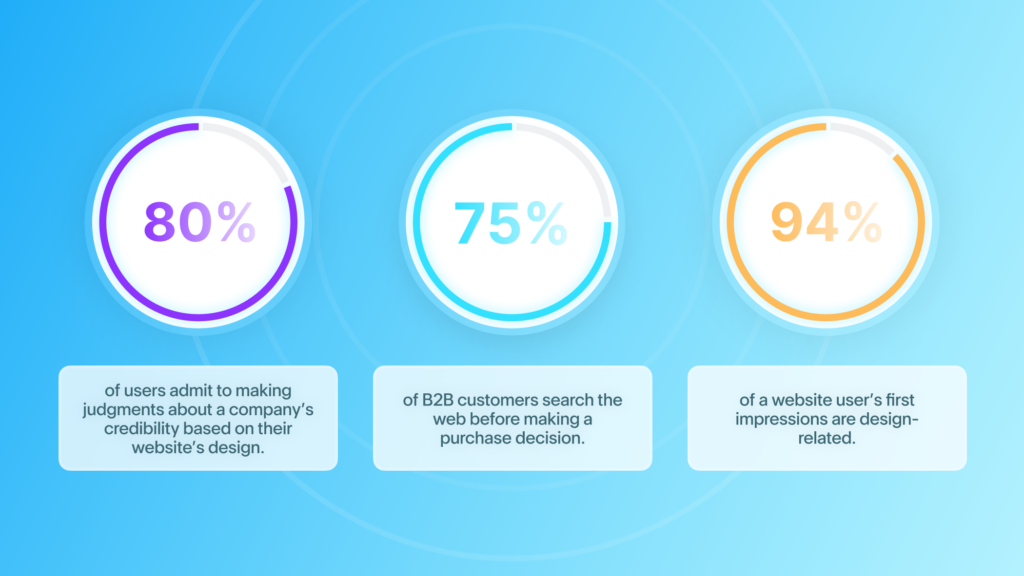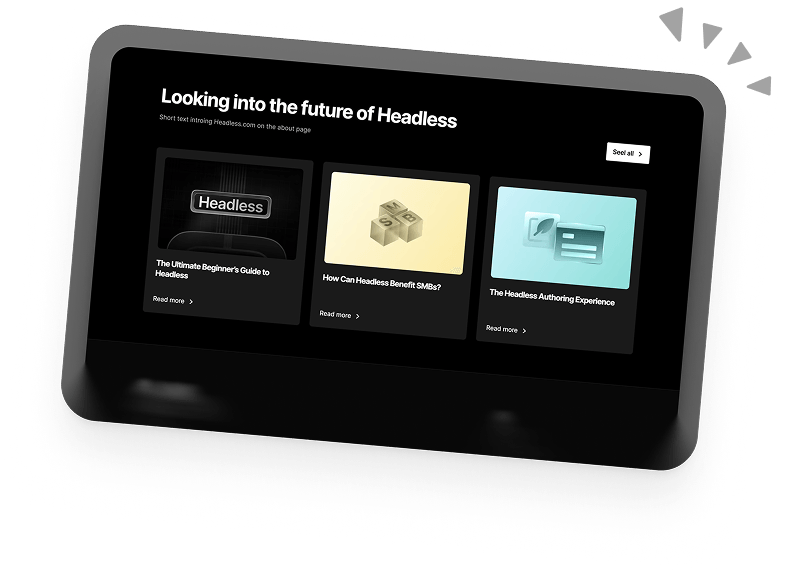8 Essential Best Practices for Your B2B SaaS Website
In our digital age, companies live and die by their website. A B2B SaaS website isn’t just a storefront – it’s the beating heart of your organisation that can make or break your success. A well-crafted site will show your best side. It will generate engagement, exemplify your brand and boost your sales.
On the flip side, a shabby site can lead to high bounce rates and leave your company by the wayside.
But, as you’ve probably realised, there’s a lot of depth to making an effective website. Your site needs to be strategically designed to stand out from the crowd, represent your products, and deliver a streamlined customer experience.
Quite a lot to juggle isn’t it? Luckily, we’ve cooked up this handy guide with everything you need to know about the best practices for making a B2B SaaS website.
Jump To…
- Best practices for engagement & conversion
- Best practices for navigation
- Best practices for CTAs
- Behind the scenes
The important role of your B2B SaaS website
In B2B SaaS, first impressions are everything. And, in a world where it only takes 50 milliseconds to judge a website, you don’t have much wiggle room. If your website doesn’t nail that first impression then, chances are, people won’t stick around to check out your products.
Although we don’t like to think so, us humans are quite superficial creatures. We have a tendency to make sweeping judgements based on our first impressions. A prime example of this is the Halo Effect: a psychological phenomenon where people transfer judgements from one attribute to another.
So, for example if we meet an attractive person, we’re more likely to perceive them as more trustworthy and intelligent.
The same goes for your website. Around 75% of customers will judge a company’s overall credibility on its website design.

If your design isn’t up to scratch, your homepage could be as far as a user ventures on their customer journey. That means all the work you put into other areas of your marketing funnel would be for nothing.
While all brands should consider how their website represents them, this is even more important in B2B SaaS. B2B buyers will spend more time researching a brand before making a purchase. That means they’ll comb through your services, blogs, and review sites to discover as much as possible about your offerings.
Your website is the central point of all this research, where you get the opportunity to control their impression of your brand and showcase your best side. Don’t waste it!
Best Practices for Engagement & Conversion
#1 Nail your home page’s structure and hierarchy
Structure, structure, structure. Without a clear information architecture that’s easy to browse and understand, your visitors aren’t going to stick around.
Look at your homepage critically, put yourself in your customers’ shoes and look for areas that could be unclear or disrupt the flow of their navigation.
When crafting the design of your homepage, aim for the following characteristics:
- Un-crowded – Give everything enough space to stand out on its own. Reducing clutter lets users quickly scan a page
- Clear visual hierarchy– Make it clear what the most important piece of information on the page is. Use spacing, font size, and colours to place emphasis on key elements and direct the user’s attention.
- Simple – Your customers should be able to quickly understand what your business is about. If your message is too complex, it’s time to simplify.
If you nail these three main areas, your homepage will capture your audience’s attention, make a good impression, and avoid confusion.
#2 Use social proof to build trust and show authenticity
You can claim your business is the best in the game. You can say you’re an industry leader. You could even say you’re a top choice for clients. None of that will matter if you haven’t got real customer stories to back it up.
There’s a quote I like on this topic from “Scientific Advertising” by Claude C Hopkins. While this book was written way back in 1923, the concepts still hold true for modern advertising.
Hopkins writes: “One expects a salesman to put his best foot forward and excuses some exaggeration born of enthusiasm. But just for that reason general statements count for little.”
Essentially, we all expect brands to say that their products are the best. These types of claims don’t have much effect on a purchasing decision. On the other hand, third-party opinions and specific, real-world examples are powerful. They cut through the marketing-speak.
This is why social proof, reviews, and customer success stories are such an essential part of your website. This is especially true in the field of B2B SaaS, where customers are hyper-critical about finding the best fit for their company. To get through to them, you’ll need cold hard evidence.
Your home page should prominently feature:
- Reviews
- Testimonials
- Case studies
Some of the benefits of having social proof on your site include:
- Authenticity – Trust is everything in the B2B SaaS market.
- Transparency – Honest reviews, even if they’re not perfect, boost your credibility.
- An incredible 270% conversion improvement rate – I mean, what’s not to love?!
Case Studies and Customer Success Stories
Case studies are a crucial form of social proof. When posting a case study, try to include images and statistics wherever possible. Remember: Be specific.
If you can, try and get a quote from the customer to include in the case study. You can also use this testimonial elsewhere on the site. Make sure to include a picture of the customer (with their permission of course) and a link to their website for extra credibility.
To get a sense of how effective this tactic can be, let’s look at a couple of examples.
Example #1: Kentico
Here’s an example from a case study by Kentico. They’ve included statistics illustrating the positive outcome of their work and presented them in a bold, eye-catching way. After all, that’s what people are looking for in case studies. They want to know if you can get results.
Under that, they have a quote from their client which adds weight to the statistics and further boosts their credibility.
Example #2: Semrush
This example from Semrush is particularly brilliant. Their site features a selection of testimonials grouped by the service that was provided for that client.
They’re using testimonials in the same way you might list features and benefits on a product page. Only, this is so much more effective. Every feature of their product has multiple people endorsing it, so we are more inclined to believe their claims.
Reviews:
If possible, include external links to verified review sites like TrustPilot, Clutch, or G2. When researching products, people are more likely to trust a third-party review site as they can be sure they’re getting an unbiased review.
You don’t need to worry about not having a perfect 5 star rating. In fact, sometimes a perfect 5 stars will look a little “too perfect.” Most customers will actively seek out negative reviews in order to get a balanced perspective of a product or service. Having a few less than stellar reviews on TrustPilot isn’t something you need to be scared of. Unless you’re getting overwhelmingly negative reviews then it will just show the authenticity of your company.
#3 Keep your style and branding consistent
Another important aspect of creating an effective B2B SaaS Website is to make sure your style is consistent throughout. Nothing is worse than a site that doesn’t feel cohesive. It’s like watching a movie and suddenly spotting a continuity error or seeing the cameraman in a reflection. You feel less immersed in the story and the characters and you might even end up watching the film more critically and looking out for more errors.
Similarly, without consistency on a website, users can end up feeling confused or even frustrated. It interrupts the flow and immersion of the experience and can negatively impact the way they perceive your brand.
Luckily, the solution to this is relatively simple.
By establishing style guides for your brand’s design and tone of voice, you’ll have a constant frame of reference as you develop your branding.
These guidelines will allow everyone on your team to have a shared goal and understanding and result in a more cohesive finished product. This is also useful if, for example, you hire new team members or take on freelancers, as they can quickly get up to speed on your branding and hit the ground running.
Here are some examples of things you’d find in branding guidelines.
For a web design style guide you would lay out rules for things like:
- Colour palette
- Typography
- Layout and spacing
- Iconography
- How to use your brand’s logo
With a tone of voice style guide you can cover:
- Your brand’s core values
- Formal and informal vocabulary
- Spelling and grammar conventions
- Your brand’s “personality”
Along with design and tone of voice, your brand guidelines can feature broader information about your brand such as:
- Market positioning
- Buyer personas
- Core values
- Mission statement
To get an idea of what these guides look like, check out these examples from some well-known brands:
Remember, with a consistent style comes a consistent UX for your customers.
An established set of guidelines will:
- Eliminate internal confusion around design.
- Save time when creating new design variations.
- Strengthen brand recognition
- Make your site’s UI more intuitive
Of course, while visual consistency comes to mind here, remember that functional consistency is also important. As users become more familiar with your brand, they should be able to anticipate how something works as they expect a similar experience across all deployments.
Best Practices for Calls to Action
Websites live and die by their call to actions. Well-placed CTAs can improve the conversion rate of a landing page by 80%. But CTAs only work when done correctly.
Just like creating a website architecture that’s easy to understand, your writing should be intuitive.
Vague CTAs like “click here” and “learn more” tell us very little about where the link will take us. What exactly are we going to learn more about?
If you use vague verb selections, you don’t give your customers the context they need to understand. If possible, use a specific reference to what a user will experience if they click that link. The following examples don’t leave any room for doubts about what will happen when someone clicks on them:
- How it works
- Speak to a support agent
- Find a course
With that in mind, here are some essential tips to keep in mind when crafting your CTAs.
#1 Use the 4 S’s of link labelling
Creating great CTAs is all about using language to connect to people. While you don’t need a degree in linguistics, it does help to understand what people will think or feel when reading your link text.
To make your CTAs more effective for end users, make sure they adhere to the 4 S’s of link labelling.
- Specific – Vagueness takes the wind out of your CTA sails. Be specific, direct, and clear.
- Sincere – A link should deliver the user to exactly where you promise. If they click to learn more only to get a link to buy a service, you’ve misled your customer.
- Substantial – Over 80% of all internet users only skim-read content. Your CTAs should be large enough to stand out from the crowd and capture a reader’s attention.
- Succinct – A long, meandering link loses its purpose as people are less likely to read it.
CTAs that have all four of these factors serve a specific purpose on your page. With these, customers will know how to interact with your website and what they’re going to get from each click.
It’s also important to remember that while CTAs are important, you shouldn’t flood your site with them. Overwhelming your reader with potential avenues to explore will decrease their likelihood of clicking on anything.
Where possible, trim the fat to make your page as sleek as possible.
#2 Plan your user journeys
Not every visitor to your B2B SaaS website fits into the same segment. On any given day, you could have visitors who have never heard of your site before, seasoned customers, and people returning to learn more about your company.
On any given day, your site will be getting visitors who:
- Arrived from Google
- Clicked on an ad
- Landed on your homepage from a direct link
- Are returning customers
To plan for all these potential interactions, you need to think about each user’s journey in turn.
Each one of your customers will look for a different service. A new customer wants information; a customer further on in your marketing funnel wants to book a demo.
Planning for all of these potential interactions is a great way to satisfy every customer that comes to your website. Let’s take a look at Microsoft’s site as an example:
Their CTAs, while meeting each of the four Ss we detailed above, are also tailored to different audiences.
A new customer is more likely to click on the first CTA. “Watch the Microsoft Teams overview”, knowing that it will give a general outline of what to expect from the product.
Alternatively, “Get 5 tips for improving collaboration” accommodates people who are already using the service. This visitor is already a customer but wants to streamline their use of the product even more.
Microsoft achieves this balance by creating CTAs that address several points in the customer journey.
Focusing on different CTAs that satisfy each of these categories will also help you diversify your content and create a winning homepage.
Behind the Scenes
While your frontend is the direct point of contact between your site and your customers, you can’t forget about the magic that makes it all happen.
Your site’s backend makes sure that everything works properly, loads quickly and, crucially, manages all the most important functionality for your sales pipeline.
With data analytics, segmentation, automation, Customer Relationship Management (CRM) systems, and other tools, your backend does a lot of the heavy lifting when it comes to moving people through the marketing funnel.
So, if you want to make your site really stand out in the B2B SaaS market, you need to make sure you have:
- The right CMS
- A proper Martech stack
- Your marketing tools integrated with your CMS
With a properly integrated tech stack, the process of nurturing your customers and leads becomes a whole lot easier. This is especially important in the world of B2B SaaS, where you rely heavily on customer relationship management.
Some important tools are:
- CRM platform – Understanding who your customers are and the actions they’ve taken with your site will ensure you always land on the right foot.
- Data analytics – Data is power. Data-driven customer interactions help your business meet your customers exactly where they are and understand their needs and pain points.
- Email capture – Email marketing is a powerful form of connecting with your audience. Email newsletter sign-ups will help build rapport with your customers.
- Automation– Where possible, automation will reduce your workload while improving the customer experience.
When these tools are properly integrated into your CMS, you can provide a truly personalised digital experience. You’ll be able to see all of your customer data in one place, saving you a lot of time and hassle and speeding up your customer relations processes.
Not only that, but with proper integration, your platforms can “talk to each other”. Data from the website can automatically go into your CRM or email automation platform. So you can say goodbye to hours of tedious data entry and late nights spent copy pasting numbers from one system to another.
Effectively, you can create an ecosystem of personalisation tools to streamline and enhance your interactions with clients.
Wrapping Up
As websites are regularly the first point of contact between a customer and your business, we want to do everything possible to make them stand out.
Having an eye-catching website is one of the defining factors of a successful B2B SaaS business. With a great site, you’ll have a solid foundation that helps everything else neatly fall into place.
Book a 30-min Introduction Call
Let's jump on a quick intro call We'll break down your project, and pinpoint exactly how we can help.



Our clients  Holaa! love working with us see their stories below!
Holaa! love working with us see their stories below!






